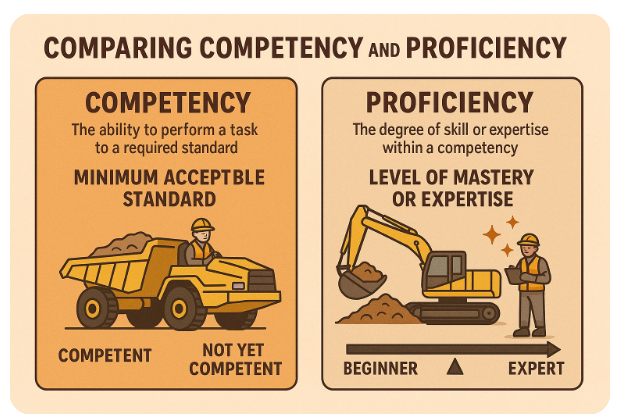
The prerequisites for aligning IT & OT to deliver a proficient workforce
Gaps in planning and an inability to drive planning decisions all the way to the work front is one of the root causes identified by Dr. Bernd Elser, Accenture’s Global Lead for Natural Resources, for the $67 billion production shortfall miners have experienced over the last 5 years.
A closer look at the other root causes identified by Dr. Elser (unplanned downtime, shortage of skilled labour & logistical constraints) reveals the role planning has in either making or breaking these factors also and will drastically reduce the effectiveness of both IT and OT (operational technology) initiatives if planning is not sufficiently detailed nor integrated across the business.
This is nowhere more evident than in workforce management. Detailed planning decisions defining the exact number and nature of the competencies required to execute the mine plan must be designed to filter down through HR & recruiting to fill the precise roles and Onboarding, Mobilization and ongoing Skills Management and Training to ensure the right people and are available at the right time, with the right skills.
For Example
A shutdown in an underground mine requires electricians, and the Mine Plan should indicate the nature and number required for a specific task.
If the plan only specifies electricians and doesn’t differentiate between Mine Electricians, High-Voltage Electricians, Instrumentation Electricians, Hazardous Area Electricians, Mine Power Systems Electricians etc… then downtime and production delays due to incomplete teams or missing competencies are inevitable.
Standard Roles
The first step in achieving this “connectedness” is ensuring that the appropriate granularity is captured in the Mine Plan, by investing in developing and maintaining well-defined Standard Roles. Standard Roles should be defined for all roles required on site and capture both the differences and commonalities for related roles eg. Mine Electrician Vs High-Voltage Electrician. This will not only ensure the right roles are scheduled to appropriate tasks, but also reveal the opportunity for training of existing workers to fill new roles.
The so called “Connected Mining Solution”, where the Mine Plan is connected via core ERP functions and Work Force Management & Safety systems, right to the “shopfloor”, is the first step in ensuring a proficient workforce is available to deliver the plan through each milestone. Additional steps can then be taken to avoid the productivity losses associated with incomplete teams and mismatched skills.

- Labor ShortagesWorkforce efficiency is not just about filling positions; it’s about ensuring proficiency. Recruitment efforts should focus on targeted hiring while automation can supplement gaps in the labor force. Finally ongoing training is required to make the most of your existing workforce. However, success in these areas also depends on a structured training and proficiency validation system that ensures workers have the right skills and capabilities required by the Mine Plan to maximize productivity and increase production output.
- Capacity Bottlenecks
Integrated planning and scheduling are critical to avoiding bottlenecks. Implementing AI-driven forecasting tools and improving resource allocation, will help companies anticipate operational constraints before they occur. Having a workforce that is not only present but proficient ensures that constraints are handled efficiently and that production goals are met consistently. - Insufficient Scheduling
Scheduling inefficiencies arise when the workforce management system does not account for proficiency levels at the right time. A proficiency-based workforce system ensures that employees are scheduled based on validated competencies, reducing inefficiencies and downtime and increasing mining production.

Proficiency Over Competency: Building a Workforce That Delivers
A workforce management system focused on proficiency is necessary to ensure that employees not only meet basic competency requirements but also achieve operational excellence. This system should be seamlessly integrated with mine planning, HR recruitment, onboarding, and continuous development programs.
Incomplete teams and unverified skill sets account for up to 20% of lost productivity. Instead of simply filling roles, companies must ensure that their workforce has both the required skills and real-world proficiency to execute tasks effectively. Workforce gaps often stem from inadequate visibility into skill levels, leading to teams that lack the required expertise for optimal performance, ultimately reducing mining production potential.
Summary
| Problem | Solution |
| Lack of an end-to-end process for managing workforce proficiency | Real-time visibility into workforce skills, training status, and operational readiness. Well-defined “standard roles” in Mine Plan filtering down to work front. |
| Incomplete Teams resulting in 12% to 17% productivity loss | Automated systems for managing high-turnover workforces, integrating remote onboarding and skills verification, to ensure right people at the right time. |
| Wrong skills or missing competencies and proficiencies causing an additional 10% to 20% productivity loss | A practical assessment framework that validates hands-on proficiency before employees begin their shifts |
The right workforce solution exists. Contact Tutis (hello@tutis.com.au) today to discover how an integrated, proficiency-based workforce management system can help your company close the production gap and drive sustainable profitability.
See our next blog for case studies and an analysis of the common Incomplete Teams and Skills Mismatch problems and how Proficiency-based hiring and training can alleviate these common problems.
